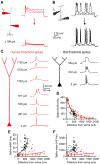Enhanced Dendritic Compartmentalization in Human Cortical Neurons
- PMID: 30340039
- PMCID: PMC6197488
- DOI: 10.1016/j.cell.2018.08.045
Enhanced Dendritic Compartmentalization in Human Cortical Neurons
Abstract
The biophysical features of neurons shape information processing in the brain. Cortical neurons are larger in humans than in other species, but it is unclear how their size affects synaptic integration. Here, we perform direct electrical recordings from human dendrites and report enhanced electrical compartmentalization in layer 5 pyramidal neurons. Compared to rat dendrites, distal human dendrites provide limited excitation to the soma, even in the presence of dendritic spikes. Human somas also exhibit less bursting due to reduced recruitment of dendritic electrogenesis. Finally, we find that decreased ion channel densities result in higher input resistance and underlie the lower coupling of human dendrites. We conclude that the increased length of human neurons alters their input-output properties, which will impact cortical computation. VIDEO ABSTRACT.
Keywords: biophysics; compartmentalization; computation; cortex; dendrite; human; ion channels; neuron; patch-clamp.
Published by Elsevier Inc.
Figures







Comment in
-
Human Cortical Dendrites: Stretched to Perform Better?Cell. 2018 Oct 18;175(3):635-637. doi: 10.1016/j.cell.2018.09.052. Cell. 2018. PMID: 30340035
-
Are Human Dendrites Different?Trends Cogn Sci. 2020 Jun;24(6):411-412. doi: 10.1016/j.tics.2020.03.002. Epub 2020 Mar 30. Trends Cogn Sci. 2020. PMID: 32392467 Free PMC article.
Similar articles
-
Efficient Low-Pass Dendro-Somatic Coupling in the Apical Dendrite of Layer 5 Pyramidal Neurons in the Anterior Cingulate Cortex.J Neurosci. 2020 Nov 11;40(46):8799-8815. doi: 10.1523/JNEUROSCI.3028-19.2020. Epub 2020 Oct 12. J Neurosci. 2020. PMID: 33046549 Free PMC article.
-
Dendritic voltage-gated ion channels regulate the action potential firing mode of hippocampal CA1 pyramidal neurons.J Neurophysiol. 1999 Oct;82(4):1895-901. doi: 10.1152/jn.1999.82.4.1895. J Neurophysiol. 1999. PMID: 10515978
-
Dendritic spikes in apical dendrites of neocortical layer 2/3 pyramidal neurons.J Neurosci. 2007 Aug 22;27(34):8999-9008. doi: 10.1523/JNEUROSCI.1717-07.2007. J Neurosci. 2007. PMID: 17715337 Free PMC article.
-
Rethinking Single Neuron Electrical Compartmentalization: Dendritic Contributions to Network Computation In Vivo.Neuroscience. 2022 May 1;489:185-199. doi: 10.1016/j.neuroscience.2021.05.038. Epub 2021 Jun 8. Neuroscience. 2022. PMID: 34116137 Review.
-
Dendritic integration in pyramidal neurons during network activity and disease.Brain Res Bull. 2014 Apr;103:2-10. doi: 10.1016/j.brainresbull.2013.09.010. Epub 2013 Oct 2. Brain Res Bull. 2014. PMID: 24095722 Review.
Cited by
-
HCN channels at the cell soma ensure the rapid electrical reactivity of fast-spiking interneurons in human neocortex.PLoS Biol. 2023 Feb 6;21(2):e3002001. doi: 10.1371/journal.pbio.3002001. eCollection 2023 Feb. PLoS Biol. 2023. PMID: 36745683 Free PMC article.
-
Hyperpolarization-Activated Cation Channels Shape the Spiking Frequency Preference of Human Cortical Layer 5 Pyramidal Neurons.eNeuro. 2023 Aug 29;10(8):ENEURO.0215-23.2023. doi: 10.1523/ENEURO.0215-23.2023. Print 2023 Aug. eNeuro. 2023. PMID: 37567768 Free PMC article.
-
Widespread and Highly Correlated Somato-dendritic Activity in Cortical Layer 5 Neurons.Neuron. 2019 Jul 17;103(2):235-241.e4. doi: 10.1016/j.neuron.2019.05.014. Epub 2019 Jun 6. Neuron. 2019. PMID: 31178115 Free PMC article.
-
Comprehensive Genome-Wide Approaches to Activity-Dependent Translational Control in Neurons.Int J Mol Sci. 2020 Feb 26;21(5):1592. doi: 10.3390/ijms21051592. Int J Mol Sci. 2020. PMID: 32111062 Free PMC article. Review.
-
Dendrites help mitigate the plasticity-stability dilemma.Sci Rep. 2023 Apr 21;13(1):6543. doi: 10.1038/s41598-023-32410-0. Sci Rep. 2023. PMID: 37085642 Free PMC article.
References
-
- Beaulieu-Laroche L, and Harnett MT (2018). Dendritic Spines Prevent Synaptic Voltage Clamp. Neuron 97, 75–82.e73. - PubMed
-
- Carnevale NT, and Hines ML (2006). The NEURON Book (Cambridge: Cambridge University Press; ).
-
- Connors BW, Gutnick MJ, and Prince DA (1982). Electrophysiological properties of neocortical neurons in vitro. Journal of neurophysiology 48, 1302–1320. - PubMed
Publication types
MeSH terms
Substances
Grants and funding
LinkOut - more resources
Full Text Sources
Other Literature Sources

